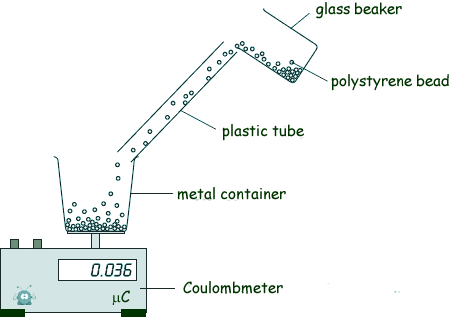GCSE Questions: Static Electricity
Q6.
(a) Fine powders poured through a pipe can collect a charge.
A student carries out an experiment to investigate this effect.

The student pours 75 cm3 of polystyrene beads down the pipe. The beads fall into a metal can and the charge on them can then be measured directly using a coulombmeter. The coulomb meter measures the charge in microcoulombs.
1.0 C = 1,000,000 µ C
The student repeats this procedure twice more, but each time uses 75 cm3 of beads of a different size.
(i) When they fell through the pipe, the polystyrene beads became negatively charged. Explain how this happened.
Friction between the beads and pipe  causes electrons
causes electrons  to transfer from the pipe to the beads.
to transfer from the pipe to the beads. 
(3 marks)
(ii) Give one control variable in the student's investigation.
Any one of the following:
volume of beads 
 length of pipe
length of pipe 
 speed the beads are poured
speed the beads are poured
 angle of pipe
angle of pipe 
(1 mark)
(b) The results obtained by the student are shown in the table.
Diameter of polystyrene beads /mm |
Charge / µ C |
1.0 |
0.080 |
2.0 |
0.044 |
3.0 |
0.012 |
(i) Describe the connection between the size of the polystyrene beads and the total charge on the beads.
(1 mark)
The larger the beads the less the charge collected on them. 
(ii) Explain how these results might be different if the student had used a shorter pipe.
(2 marks)
Less (total) charge would be gathered  as the beads would be in contact with the pipe for a smaller time (or would be in contact with less surface area of pipe).
as the beads would be in contact with the pipe for a smaller time (or would be in contact with less surface area of pipe). 
(c) In industry, powders are often pumped through pipes. If the static charge caused a spark, the powder could ignite and cause an explosion.
(i) Is an explosion more likely to happen when pumping very fine powders or when pumping powders that consist of much larger particles?
Give a reason for your answer.
Pumping very fine powders results in a greater charge build up than in a power with larger grains. This makes static discharge (sparking) more likely. Therefore pumping fine powders is more hazardous than pumping those of coarse grains. 
(1 mark)
(ii) Suggest one way that the risk of an explosion could be reduced.
Earthing (the pipe) or using metal pipes would help reduce charge build up.
(1 mark)
(d) The table gives the minimum ignition energy (MIE) value for a number of fine powders. The MIE is the minimum amount of energy required to cause a fine powder to ignite.
Type of powder |
MIE /mJ |
Coal dust |
60.00 |
Aluminium powder |
10.00 |
Cornstarch dust |
0.30 |
Iron powder |
0.12 |
The MIE values for different substances are all measured in the same way and under the same conditions of pressure and temperature. Why is this important?
In order to compare the relative risks of the powders you need to show how they all perform when all other variables are controlled. You can only have one independent variable. In this case it is the type of powder. Therefore the chemical properties of the substances relating to possible ignition when in powder form can be fairly compared. 
(1 mark)
[Total 10 marks]


